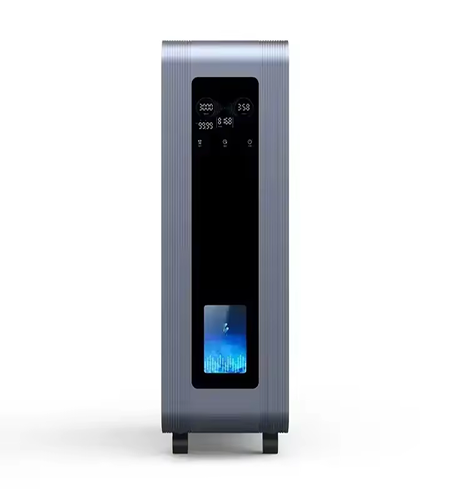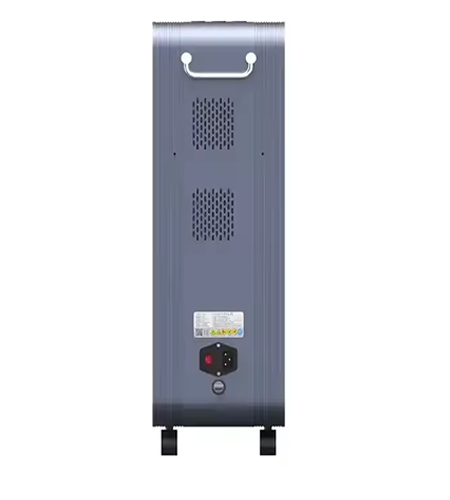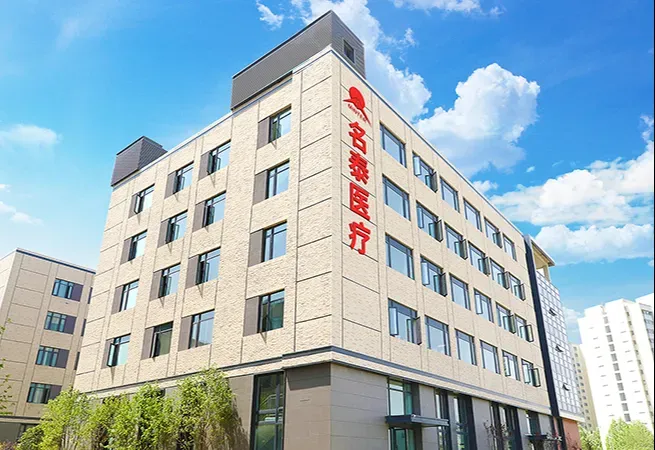
ကျန်းမာရေး စောင့်ရှောက်မှုလုပ်ငန်းမှာ နာမည်ကြီးတဲ့ မိတ်ကပ်တစ်ခုဖြစ်တဲ့ Minter ဟာ မကြာသေးခင်က သူ့ရဲ့ ဆန်းသစ်တဲ့ ဟိုက်ဒရိုဂျင် ရေထုတ်စက်ကို မိတ်ဆက်ခဲ့ပါတယ်။ ဒီဆင့်ကဲထုတ်ကုန်ဟာ ကျန်းမာရေးအတွက် အကျိုးကျေးဇူးများစွာနဲ့ ကျော်ကြားတဲ့ သန့်ရှင်းပြီး ဘေးကင်းတဲ့ ဟိုက်ဒရိုဂျင်ရေကို သုံးစွဲသူတွေအတွက် ပေးဖို့ ဒီဇိုင်းထုတ်ထားပါတယ်။ ဟိုက်ဒရိုဂျင် ရှူသွင်းစက်များ၊ ဟိုက်ဒရိုဂျင် ရေပုလင်းများ၊ သွားကုသရေးပစ္စည်းများ၊ အသားညှစ်ဆေးထုတ်ကုန်များနှင့် ရုပ်ပိုင်းကုသရေးကိရိယာများကဲ့သို့ ကျန်းမာရေးစောင့်ရှောက်မှု ထုတ်ကုန်များ၏ ဦးဆောင်ပေးသွင်းသူအဖြစ် Minter ၏ ဟိုက်ဒရိုဂျင်ရေထုတ်စက်သည် ပိုမိုကျန်းမာသော ဘဝ
ဟိုက်ဒရိုဂျင်ရေထုတ်စက်: ကျန်းမာရေးစောင့်ရှောက်မှုတွင် ဂိမ်းပြောင်းစက် Minter မှ ဟိုက်ဒရိုဂျင်ရေထုတ်စက်သည် ဟိုက်ဒရိုဂျင် ကြွယ်ဝသော ရေထုတ်လုပ်ရန် အဆင့်မြင့်နည်းပညာကို အသုံးပြုသည့် ထူးခြားသော ထုတ်ကုန်ဖြစ်သည်။ ဒီရေဟာ ပဋိဇီဝဓာတ်တွေ ကြွယ်ဝပြီး စွမ်းအင်အဆင့်ကို မြှင့်တင်ပေးတယ်၊ အစာခြေခြင်းကို တိုးတက်စေပြီး ယေဘုယျ ကျန်းမာမှုကို ထောက်ပံ့တယ်လို့ သက်သေပြထားတယ်။ အခြားရေစစ်စနစ်များနှင့်မတူဘဲ ဟိုက်ဒရိုဂျင်ရေထုတ်စက်သည် ရေကိုသန့်စင်ရန် ဓာတုပစ္စည်းများ သို့မဟုတ် အလွှာပါးများအပေါ် မမှီခိုပါ။ ဒီအစား ရေမော်လီကျူးတွေကို ဟိုက်ဒရိုဂျင်နဲ့ အောက်ဆီဂျင် ဓာတ်ငွေ့တွေအဖြစ် ခွဲဖို့ လျှပ်စစ်ဓာတ်ခွဲလို့ခေါ်တဲ့ လုပ်ငန်းစဉ်ကို သုံးပါတယ်။ ရလာတဲ့ ဟိုက်ဒရိုဂျင်ဓာတ်ငွေ့ကို ရေသန့်ထဲမှာ ပျော်ဝင်စေပြီး ဘေးဖြစ်စေတဲ့ လွတ်လပ်တဲ့ အစွန်းတွေမှ ကာကွယ်ပေးနိုင်တဲ့ အားကောင်းတဲ့ anti-oxidant solution ကို ဖန်တီးပါတယ်။

Minter တံဆိပ်အမည်သည် ကျန်းမာရေး စောင့်ရှောက်မှုလုပ်ငန်းနှင့် တူညီပြီး ယခုအခါ ၎င်း၏ ခေတ်မီဆုံး ဟိုက်ဒရိုဂျင် ရှူသွင်းစက်ကို ထုတ်ဝေထားပြီး ၎င်း၏ ဖောက်သည်များ သို့မဟုတ် ဝန်ထမ်းများအတွက် ကျန်းမာမှု အစီအစဉ်များကို ဖန်တီးလိုသော ကုမ္ပဏီများက အသုံးပြုနိုင်သည်။ ၎င်းသည် ကုသမှုအတွေ့အကြုံတစ်ခု ပေးနိုင်ရန်အတွက် ယခင်က မသိခဲ့သည့် အဆင့်မြင့် အဆင့်များရှိ ဟိုက်ဒရိုဂျင်စွမ်းအင်ကို အသုံးပြုသည်။ ထို့ကြောင့် ၎င်းသည် ကျန်းမာမှုစင်တာများ၊ အလှအပ အားကစားရုံများနှင့် စီးပွားရေးကျန်းမာရေး အစီအစဉ်များအတွက် သင့်တော်သည်။
ဟိုက်ဒရိုဂျင်သုံးတဲ့ ကျွန်မတို့ရဲ့ ရှူသွင်းစက်တွေဟာ သိပ္ပံပညာအပြင် သက်တောင့်သက်သာ ဖြစ်အောင် လုပ်ပေးကြလို့ အခြားဟာတွေနဲ့ မတူပါဘူး။ ပုံမှန်အားဖြင့် ၎င်းသည် အလွန်သန့်စင်သော မော်လီကျူး ဟိုက်ဒရိုဂျင်ကို ထုတ်လုပ်ပေးခြင်းဖြင့် Antioxidants လိုအပ်သော လူများ၏ ရှူသွင်းခြင်းဖြင့် ဘေးကင်းစွာ အသုံးပြုနိုင်ခြင်းဖြစ်ပါသည်။ ဒါဟာ အစပျိုးသူအတွက်တောင် ရိုးရှင်းအောင် လုပ်ထားတာပါ။ တစ်ဦးဦးဟာ လိုအပ်ချက်တွေကို အမှီပြုပြီး အသွင်သဏ္ဍာန်တွေကို ကိုယ်ပိုင်ပြုပြင်နိုင်ပြီး တစ်ဦးချင်းစီအတွက် အရေးပါဆုံး နေရာတွေမှာ မတူညီတဲ့ အလုပ်နေရာတွေအတွက် အကောင်းဆုံး သင့်တော်စေပါတယ်။

ကျန်းမာရေး စောင့်ရှောက်မှုမှာ ရှေ့တန်းမှာ ရှိနေဖို့က Minter မှာ ကျွန်တော်တို့ရဲ့ ရည်မှန်းချက်ပါ။ ကျွန်ုပ်တို့၏ ခေတ်မီသော ဟိုက်ဒရိုဂျင် ရှူသွင်းစက်သည် ဆေးကုသမှုဆိုင်ရာ ရည်ရွယ်ချက် အမျိုးမျိုးအတွက် အမာခံ ဟိုက်ဒရိုဂျင် ဓာတ်ငွေ့ ကုသမှုကို ပေးနိုင်စွမ်းရှိပြီး ဤလုပ်ငန်းစဉ်တွင် အလားအလာသစ်ကို ပြသပေးနေသည်။ ကျွန်တော်တို့ဟာ အတော်ကြာကြာ လုပ်ကိုင်လာခဲ့ကြတာမို့လို့ ကျန်းမာရေး စောင့်ရှောက်ရေး လုပ်ငန်းရဲ့ လက်ရှိ လိုအပ်ချက်တွေကို ဖြည့်ဆည်းပေးနိုင်မယ့် အရည်အသွေးကောင်းတဲ့ ပစ္စည်းတွေကို ထုတ်လုပ်ဖို့ လိုအပ်တာကို သိကြပါတယ်။
Minter ရဲ့ ဟိုက်ဒရိုဂျင် ရှူသွင်းစက်ကို ထုတ်လုပ်ရာတွင် နောက်ဆုံးပေါ် နည်းပညာများနှင့် တင်းကျပ်သော ထုတ်လုပ်မှု စည်းမျဉ်းများ အသုံးပြုထားသည်။ ကျွန်တော်တို့ရဲ့ ရှေးရိုးဆန်တဲ့ စက်ရုံမှာ ဒီစက်တွေကို ကျွန်တော်တို့ရဲ့ ကျွမ်းကျင်တဲ့ အလုပ်သမားတွေကြောင့် တိကျမှုနဲ့ ထူးချွန်မှုတွေနဲ့ ထုတ်လုပ်ပါတယ်။ ဟိုက်ဒရိုဂျင် ရှူသွင်းကုသမှုသည် ရောင်ရမ်းခြင်း၊ အောက်ဆီဒေ့ရှင်း လျော့နည်းစေခြင်းနှင့် တစ်ကမ္ဘာလုံးတွင် ကောင်းမွန်စွာ လက်ခံထားရသည့် အထွေထွေဆဲလ် စွမ်းဆောင်ရည် တိုးတက်စေခြင်းတို့တွင် ၎င်း၏ အလားအလာ ကောင်းကျိုးများကြောင့် သိရှိရသည်။ ဒီတော်လှန်ရေး ကုထုံးက နာမကျန်းရောဂါ အမျိုးမျိုးကို ကုသဖို့ အခြားရွေးချယ်မှုတွေကို ဖြစ်ပေါ်စေခဲ့ပြီး PD (သို့) AD လို အာရုံကြောဆိုင်ရာ ရောဂါတွေ၊ COPD နဲ့ နှလုံးသွေးကြောဆိုင်ရာ ရောဂါတွေလို အဆုတ်ရောဂါတွေ အပါအဝင် အခြားရောဂါတွေအထိ မကန့်သတ်ပါဘူး။

ဟိုက်ဒရိုဂျင်ကို အသက်ရှူခြင်းဟာ သဘာဝကျပြီး ထိရောက်စွာ ကျန်းမာရေးကို မြှင့်တင်ဖို့ လူကြိုက်များတဲ့ နည်းလမ်းတစ်ခုဖြစ်လာတယ်။ Minter ဟာ ဒီကိရိယာအမျိုးအစားကို အခြား ကျန်းမာရေး စောင့်ရှောက်မှု ထုတ်ကုန်တွေအပြင် ဖန်တီးတဲ့ လုပ်ငန်းတစ်ခုပါ။ သူတို့ဟာ လူသားတွေ သိကြတဲ့ ဟိုက်ဒရိုဂျင်ကို သုံးတဲ့ အဆင့်မြင့်ဆုံး အသက်ရှူစက်ကို တီထွင်ခဲ့ကြတယ်။ ကျွန်ုပ်တို့၏ အဓိက ထုတ်ကုန်များမှာ ဟိုက်ဒရိုဂျင် inhaler၊ massage device၊ physiotherapy equipment နှင့် ဟိုက်ဒရိုဂျင်ရေပုလင်းများကဲ့သို့သော သွားစောင့်ရှောက်မှုပစ္စည်းများဖြစ်သည်။
Minter ရေဒီဂြိုဟ်ဂျင် ရှူသွင်းရေး ကိရိယာဟာ သယ်ဆောင်သွားနိုင်လောက်အောင် သေးငယ်ပြီး ကျန်းမာရေးအတွက် အကျိုးကျေးဇူး အမျိုးမျိုး ရရှိစေဖို့ အသုံးပြုသူတွေကို သန့်ရှင်းတဲ့ ရေဒီဂြိုဟ်ဂျင် ဓာတ်ငွေ့ကို ရှူသွင်းခွင့်ပေးပါတယ်။ စက်တွေက ပတ်ဝန်းကျင်လေထဲက ညစ်ညမ်းမှုတွေကို စစ်ထုတ်ပေးလို့ ဒီဒြပ်စင်ရဲ့ သန့်ရှင်းဆုံးပုံစံကိုပဲ သင်နဲ့ ကျွန်မ ရှူသွင်းနိုင်ပြီး ဒါက ရောင်ရမ်းမှုအဆင့်ကို လျှော့ချဖို့ ကူညီပြီး တစ်ချိန်တည်းမှာ ကိုယ်ခံအားစနစ်ကို အားကောင်းစေကာ ကျန်းမာမှုအသိကို တိုးမြှင့်ပေးပါတယ်။
၎င်း၏ အဓိကလက္ခဏာတစ်ခုမှာ လုံခြုံမှုဖြစ်သည်၊ ၎င်းတို့ကိုအသုံးပြုစဉ်တွင် မည်သူမျှ ထိခိုက်ဒဏ်ရာမရစေရန် ကာကွယ်ရေးစနစ်များစွာကို ထုတ်လုပ်မှုအဆင့်အတွင်းတွင် ထည့်သွင်းထားသည်၊ ဥပမာ အပူချိန်များ ထိန်းချုပ်နိုင်သော နယ်နိမိတ်များထက် မြင့်မားလွန်းသည့်အခါ အလိုအလျောက် ပိတ်ထားခြင်း လုပ်ဆောင်ချက်၊

ကျန်းမာရေး စောင့်ရှောက်မှုဆိုင်ရာ ဖြေရှင်းနည်းသစ်တွေကို ရှာဖွေရာမှာ ဟိုက်ဒရိုဂျင် အသက်ရှူစက်ကို တီထွင်ခဲ့တယ်။ ဒါဟာ Minter ကုမ္ပဏီက တီထွင်ထားတဲ့ အထူးကိရိယာမျိုးဖြစ်ပြီး Minter ကုမ္ပဏီဟာ ဒီကဏ္ဍမှာ အရည်အသွေးမြင့် ထုတ်ကုန်တွေနဲ့ ကျော်ကြားပါတယ်။ ဒီတော့ ကျွန်တော်တို့ရဲ့ ရှူသွင်းတဲ့ ကိရိယာဟာ ကျန်းမာရေး စောင့်ရှောက်မှုဆိုင်ရာ ဂိမ်းပြောင်းတစ်ခုလို့ အသေအချာ ပြောလို့ရပါတယ်။
Minter ရဲ့ ဟိုက်ဒရိုဂျင် ရှူသွင်းစက်ဟာ ထူးခြားတဲ့ ကုသမှု အတွေ့အကြုံကို ပေးဖို့ အဆင့်မြင့် နည်းပညာကို သုံးပါတယ်။ သိပ္ပံနည်းကျနည်းနဲ့ သန့်ရှင်းတဲ့ ဟိုက်ဒရိုဂျင် ဓာတ်ငွေ့ကို ထုတ်လုပ်ပေးပြီး ဒီဓာတ်ငွေ့ကို လူနာတွေ ရှူသွင်းပါတယ်။ ဒီမော်လီကျူးတွေဟာ ဆဲလ်တွေအတွင်းက အန္တရာယ်ရှိတဲ့ အရာတွေကို သယ်ဆောင်ပြီး ဆဲလ်အဆင့်မှာ ပိုကောင်းတဲ့ အောက်ဆီဂျင် အသုံးချမှုကို အားပေးပါတယ်။ ထို့အပြင် အဆုတ်ပတ်ဝန်းကျင်တွင် ရောင်ရမ်းခြင်းကို လျှော့ချခြင်း သို့မဟုတ် အခြားသူများအပါအဝင် စွမ်းအင်အဆင့်များကို ယေဘုယျအားဖြင့် တိုးတက်စေခြင်းကဲ့သို့ အသက်ရှူလမ်းကြောင်း လုပ်ဆောင်ချက်များကို မြှင့်တင်လိုသော ကျန်းမာရေး စောင့်ရှောက်မှုပေးသူများအတွက် မထိခိုက်မှုမရှိသော ကုသမှု ရွေးချယ်မှုတစ်ခုပေးသည်။ သံသယမရှိပဲ Minter ရဲ့ကိရိယာဟာ လုံခြုံတဲ့ လုပ်ငန်းစဉ်တွေကို အာမခံပေးပြီး လိုချင်တဲ့ ရလဒ်တွေကို ရရှိစေပါတယ်။ ဒါက ဆေးရုံတိုင်းအတွက် မရှိမဖြစ် လိုအပ်တဲ့ အစိတ်အပိုင်းတစ်ခု ဖြစ်လာစေပါတယ်။

Zhengzhou Minter Medical Devices Co., Ltd. သည် အထူးပြု ကျန်းမာရေးထုတ်ကုန်များ ပေး supply လုပ်သူတစ်ဦး ဖြစ်သည်။ နှစ်ပေါင်းများစွာ အတွေ့အကြုံရှိသော Minter သည် ၎င်း၏ ကိုယ်ပိုင် အထူးပြု သုတေသနနှင့် ဖွံ့ဖြိုးတိုးတက်မှု ဗဟိုနှင့် ဆေးဘက်ဆိုင်ရာ ကိရိယာ ထုတ်လုပ်မှု အခြေစိုက်ခွင်ကို ရှိသည်။
ကုန်ကြမ်းတွေကို သေချာရွေးချယ်ခြင်းကနေ ထုတ်ကုန်တွေကို တင်းကျပ်စွာ စစ်ဆေးခြင်းအထိ အဆင့်တိုင်းဟာ အမြင့်ဆုံး အရည်အသွေး စံနှုန်းတွေနဲ့ ကိုက်ညီတာကို သေချာစေပါတယ်။ ယခုအခါ Minter ၏ ထုတ်ကုန်အများစုသည် CE, ISO, ROHS, FCC နှင့် အခြားအမှတ်တံဆိပ်များမှ ဖြတ်သန်းခဲ့သည်။
ကျွန်ုပ်တို့၏ အဓိက ထုတ်ကုန်များမှာ ဟိုက်ဒရိုဂျင် inhaler၊ ဟိုက်ဒရိုဂျင် ရေပုလင်း၊ သွားတိုက်ထုတ်ကုန်များ၊ အလှေထိုးထုတ်ကုန်များနှင့် ရုပ်ပိုင်းကုသရေးကိရိယာများကဲ့သို့သော ကျန်းမာရေး စောင့်ရှောက်မှု ထုတ်ကုန်များဖြစ်သည်။
ကျွန်ုပ်တို့သည် အမြဲတမ်း ဖောက်သည်များ၏ ကျေနပ်မှုကို ဦးစားပေးပြီး အရောင်းအပြီး အထောက်အပံ့ကောင်းမွန်စွာ ပေးနေသောကြောင့်၊ ကျွန်ုပ်တို့၏ ထုတ်ကုန်များသည် မြောက်အမေရိက၊ တောင်အမေရိက၊ အနောက်ဥရောပ၊ အရှေ့ဥရောပ၊ အရှေ့တောင်အာရှ စသည်တို့မှ ဖောက်သည်များတွင် အလွန်လူကြိုက်များ
ကျွန်ုပ်တို့၏ R&D ဌာနသည် အားကောင်းသော နည်းပညာထောက်ပံ့မှုပေးပြီး ကမ္ဘာတစ်လွှားရှိ နိုင်ငံခြားဖောက်သည်များအတွက် OEM နှင့် ODM ကို ကမ်းလှမ်းနိုင်သည်။ ကျွန်ုပ်တို့၏ စက်ရုံသို့ လာရောက်လည်ပတ်ရန်နှင့် ကျွန်ုပ်တို့နှင့် ပူးပေါင်းဆောင်ရွက်ရေး ဆက်ဆံရေးတည်ထောင်ရန်အတွက် အိမ်နှင့် သင်္ဘောပေါ်မှ ဖောက်သည်များကို အပူအငွေ့ဖြင့် ကြိုဆိုပါသည်။ ပိုမိုပူးပေါင်းဆောင်ရွက်ဖို့ မျှော်လင့်ပါတယ်။
ထုတ်ကုန် သုတေသနနှင့် ဖွံ့ဖြိုးတိုးတက်မှုအပေါ် အာရုံစိုက်သော အထက်တန်းစားအဖွဲ့တစ်ခုရှိပြီး ထုတ်လုပ်မှု၊ ပညာရေးနှင့် သုတေသနတွင် မဟာဗျူဟာဆိုင်ရာ ပူးပေါင်းဆောင်ရွက်မှုရရှိရန်၊ နိုင်ငံတကာ အဆင့်မြင့်နည်းပညာကို မိတ်ဆက်ရန်နှင့် ထုတ်ကုန်များတွင် ပေါင်းစပ်ရန် နာမည်ကြီးတက္ကသိုလ်များစွာ
အထူးပြုမှုကို အထူးသဖြင့် Minter သည် ထုတ်လုပ်မှုလုပ်ငန်းစဉ်အတွင်း အရည်အသွေးထိန်းချုပ်မှု အစီအစဉ်များကို အကောင်အထည်ဖော်သည်။ အစွန်းရောက်သော အရည်အသွေးစံနှုန်းများကို လိုက်နာသော အဆင့်တိုင်းတွင် အရည်အသွေးအာမခံမှုအတွက် ဤအထူးပြုမှုသည် CE, ISO, ROHS, FCC ကဲ့သို့သော စံချိန်စံညွှန်းများကို အမြဲတမ်း ဖြည့်ဆည်းသော ထုတ်ကုန်များကို ဖန်တီးစေသည်။ ကမ္ဘာတစ်ဝှမ်းရှိ ဖောက်သည်များအတွက် ယုံကြည်စိတ်ချရမှုနှင့် လုံခြုံမှုကို သေချာစေသည်။
OEM/ODM ဝန်ဆောင်မှုနှင့် လုပ်ငန်းရှင်များ၏ နည်းပညာဆိုင်ရာ ထောက်ပံ့မှုများကို ပေးပို့ပေးလျက် ရှိပါသည်။
Minter ၏ ဖောက်သည်ကျေနပ်မှုနှင့် ထူးခြားသော အရောင်းပြီးနောက် အထောက်အပံ့ကို အထူးအလေးထားခြင်းသည် ၎င်း၏ ထုတ်ကုန်များကို မြောက်အမေရိက၊ တောင်အမေရိက၊ အနောက်ဥရောပ၊ အရှေ့ဥရောပနှင့် တောင်အာရှတို့အပါအဝင် အမျိုးမျိုးသော ဒေသများတွင် အထူးသဖြင့် လူကြိုက်များစေခဲ့သည်။ ဤကျော်ကြားမှုသည် အမှတ်တံဆိပ်၏ ကမ္ဘာလုံးဆိုင်ရာ ပရိသတ်နှင့် ဆက်နွယ်နိုင်မှုနှင့် အဓိက စျေးကွက်များတွင် အခိုင်အမာ ရှိနေမှုကို ဖော်ပြသည်။

30
Apr
30
Apr
30
Aprဒါဟာ အဆုတ်ထိုးဖို့ အထူးသဖြင့် ဟိုက်ဒရိုဂျင်အရည်အတွက် လေထုတ်လုပ်တဲ့ ကိရိယာတစ်ခုပါ။ ကျန်းမာရေးအကျိုးကျေးဇူးတွေကို မြှင့်တင်ပေးပါတယ်။
ဒါဟာ ရေကို အီလက်ထရိုလိုက်စ်လုပ်ပြီး ဟိုက်ဒရိုဂျင် ဂက်စ်ထုတ်လုပ်ပါတယ်၊ အသုံးပြုသူတွေကတော့ အထက်ကနေ အဆုတ်ထိုးနိုင်ပါတယ်။
မြင့်မားတဲ့ ထိရောက်မှု၊ အသုံးပြုရလွယ်ကူတဲ့ ဒီဇိုင်းနဲ့ လုံခြုံရေးအင်္ဂါရပ်တွေက ကျွန်ုပ်တို့ရဲ့ စက်ရဲ့ အထူးအချက်တွေပါ။
ပုံမှန် သန့်ရှင်းရေးလုပ်ခြင်းနဲ့ ထုတ်လုပ်သူရဲ့ ညွှန်ကြားချက်တွေကို လိုက်နာခြင်းက အရေးကြီးပါတယ်။


မူပိုင်ခွင့် © - လုံခြုံရေးမူဝါဒ